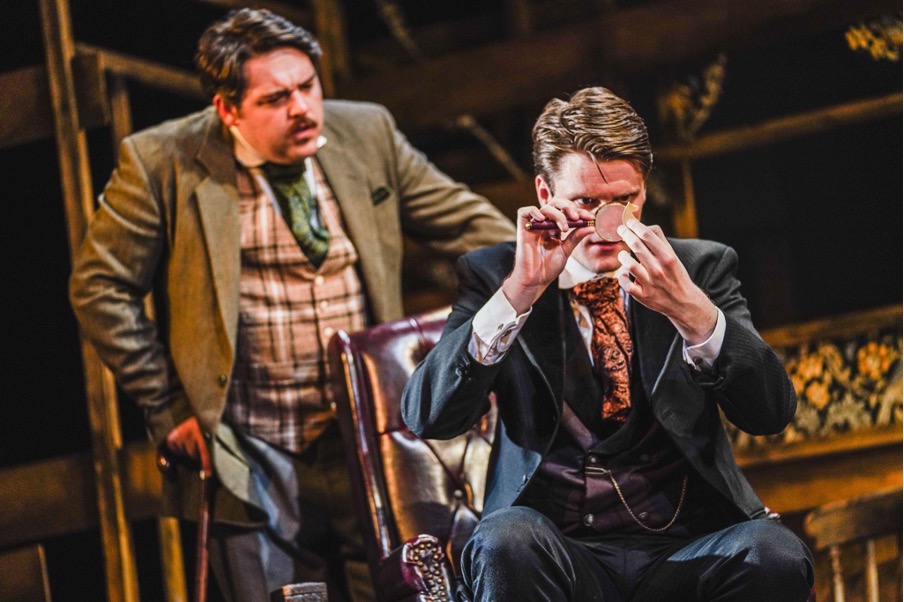HARRY SPEIRS reviews Nick Lane’s adaptation of Arthur Conan Doyle’s The Valley of Fear at the Black Eyed Theatre.
Dear Me, Mr Holmes, Dear Me, Nick Lane seems to have brought you to life again. Three years after his revival of The Sign of Four, the Black Eyed Theatre gives us hopeless Sherlock nerds another performance of a lifetime to add to our casebooks. With an adaptation of Sherlock Holmes that decides to tackle one of Conan Doyle’s most brutal and exhilarating short stories: The Valley of Fear. Our favourite sleuth tackles a case that will not only take him across the British landscape but also the Atlantic Ocean. This production puts Doyle’s perfect blend of Spaghetti Western shootout and the more typical intelligence of a clue-finding Holmes under a new magnifying glass. Nick Lane’s adaptation offers a more difficult challenge on the stage; even more impressively, it succeeds.
Holmes and Watson are sent to Birlstone manor under the premise that a Mr. Douglass has had his head blown off by a shotgun. Yet most curiously, they have already been warned of this event by a cipher in the newspaper earlier that same day. The journey will send them right into the thick of a dangerous organisation called The Scourers who have been chasing Douglass all the way from Vermissa Valley, Pennsylvania. As usual with Holmes, nothing is as it seems.

Ultimately, Lane’s adaptation stays true to the original story. Yet, carefully picked moments from the novel—such as the search for the cipher towards the beginning, the first meeting with the-one-and-only Boss McGinty, and the final revelation of the truth—are given a new life in this performance. Ingeniously, Lane places the American and English narratives, which are separated in the novel, almost simultaneously together on stage. I was expecting a similar structure to the short story where Jack McMurdo recounts his time in America, and Sherlock’s taking his case in England, are separated into two parts.. But the two were blended together with impressive skill.
At the same time, Lane gives us glimpses of Holmes under the influence of a larger narrative. Moriarty floats like a dreadful shadow over the whole piece, even stepping into the light inside an art gallery. Gavin Molloy, grinning like a Cheshire cat (clearly enjoying his time as the professor/criminal mastermind), gives one of the most convincing revivals of the criminal to be seen.
Luke Barton (Holmes) and Joseph Derrington (Watson) use influences across time to generate the relationship between their two characters. I recognised some of Jermey Brett’s influence in Barton’s raised eyebrows, some of Martin Freeman’s reliance on a walking stick that he doesn’t need in Derrington, but most importantly the swagger and pace of the Downey Jr. and Jude Law films. It was impressive to see actors using a century’s worth of successful portrayals to forge their own so well. What was most remarkable, though, was a ‘coldness’ that formed between them–an ability to both love and despise each other simultaneously. This was the original element and it left interesting questions about the dynamic duo’s compatibility. An honest depiction of a true and lifelong friendship nevertheless.

In addition, each actor impressively managed to multi-role many different characters. Stepping in and out of character is one thing, but for a whole cast to do it consistently, is no easy feat. Alice Osmansaki must get my biggest congratulations for her shapeshifting: she managed to quickly move from the quick-witted Mrs. Hudson to the iron-willed Ettie Shafter from scene to scene. Each character’s gun wielding was also a matter of pure marvel by itself. Accents, as well, were on point throughout the performance; impressively ranging, from many of London’s different twangs to several different American dialects.
The general production of this piece was frankly phenomenal in all respects: whether it was the elaborate Victorian set that swivelled in and out of place; the gorgeous costumes with their trailing coats, collars which in the typical Sherlock style always needed to be adjusted, or the classic flipping of the pocket watch the whole way through. The lighting and sound, which beautifully carried us from England to America and back again, also flipped from Christmas-cold to summer-heat with ease. All showed the other, and often forgotten, parts of a theatre working at their very best.

I attended Greenwich Theatre to see a production that was true to the old and faithful Sherlock Holmes we all think we know–Nick Lane just might prove that we aren’t even scratching the surface of what is possible with Doyle’s famous sleuth. If you have enjoyed Holmes in the past, then you will surely enjoy this production, and if it is your first time I can assure you that there are few better places to start.
Sherlock Holmes: The Valley of Fear is currently touring around the UK until 2023. For upcoming dates and locations, visit their website here.
Featured image credit: Alex Harvey Brown





